Smart Guide to the 20 Best Beaches in Crete (Updated 2025)
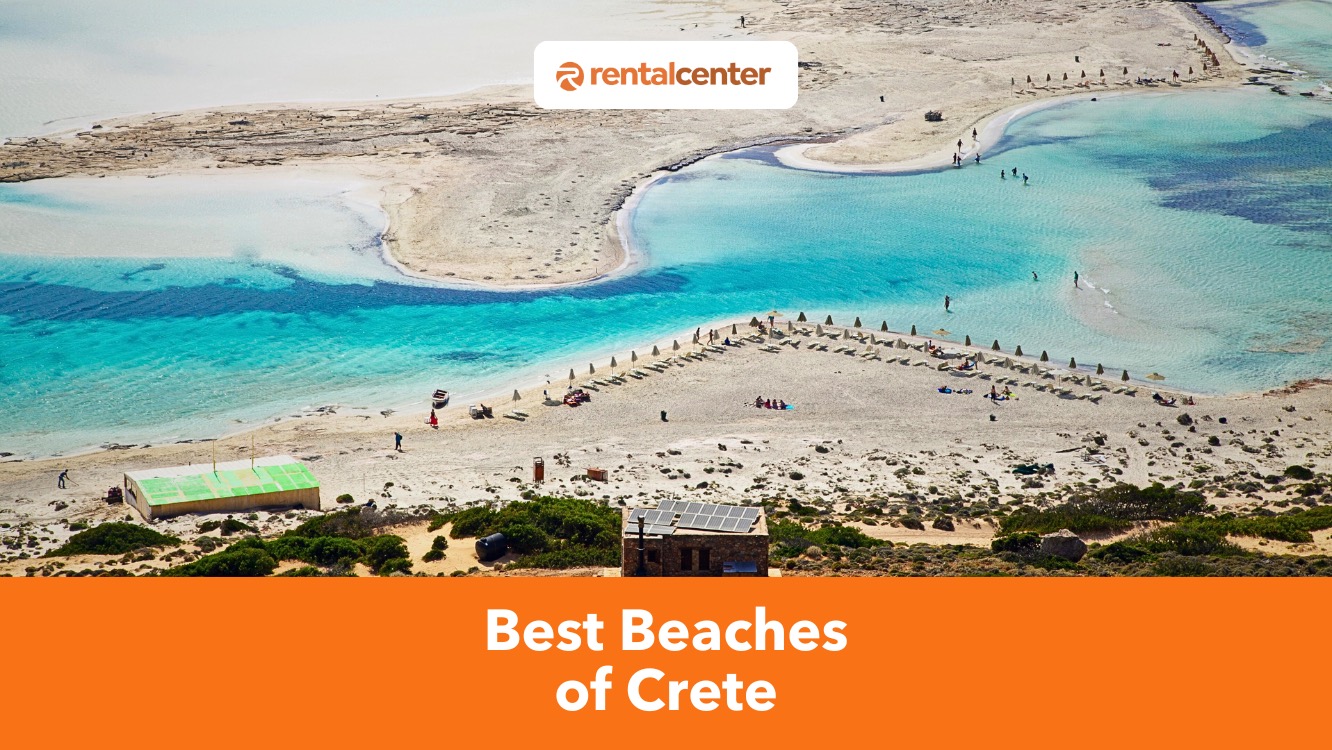
Crete is a remarkable destination for beach enthusiasts, offering a big number of stunning beaches, each with its own unique charm. Vai Beach is famous for its palm-fringed shores, providing a tropical feel in the Mediterranean. Balos Beach is recognized for its pink-tinged sands and breathtaking views, making it a must-visit spot for those seeking natural beauty.
Preveli Beach offers a serene escape with its freshwater lagoon and palm forest, perfect for those looking to unwind in a tranquil setting. Falassarna Beach is popular for its vibrant atmosphere, windsurfing opportunities, and spectacular sunsets, attracting adventure seekers and sunset lovers alike.
Kalypso Beach invites visitors to dive into its blye waters, while Red Beach offers a historical allure that captivates history buffs. Voulisma Beach is ideal for families, with its gentle sands and safe swimming conditions. Each of these beaches provides a unique experience, showcasing the diverse landscapes and rich cultural heritage of Crete. Travelers looking Crete’s beaches for relaxation, adventure, or cultural exploration.
Listed below are the best beaches in Crete.
- Preveli Beach. Preveli Beach, where the Kourtaliotikos Gorge meets the Libyan Sea, features a palm forest, golden sands, and a freshwater lagoon ideal for swimming. Preveli Beach is accessible via a scenic walk or boat and offers minimal facilities to preserve its natural beauty.
- Voulisma Beach. Voulisma Beach, also known as Golden Beach, boasts turquoise waters, white sand, and family-friendly amenities with a Blue Flag certification. Voulisma Beach is surrounded by olive groves and is close to historical ruins, making it a top choice for a relaxing seaside experience.
- Kalypso Beach. Kalypso Beach, or Pirates’ Fjord, is a secluded rocky cove offering crystal-clear waters for snorkeling and scuba diving. Kalypso Beach is accessible through the Kalypso Resort and provides tranquility with dramatic cliffs and rich marine life.
- Falassarna Beach. Falassarna Beach, one of Europe’s best, features pink-tinged sands, turquoise waters, and an expansive shoreline ideal for windsurfing. Falassarna Beach’s historical ruins and vibrant sunsets add cultural and scenic allure.
- Red Beach. Red Beach, or Kokkini Ammos, captivates visitors with its striking red sands and turquoise waters, accessible by a hike or boat. Red Beach is known for its hippie legacy and nudist-friendly atmosphere, offering a serene escape with minimal facilities.
- Elafonissi Beach. Elafonissi Beach, famous for its pink sand and shallow lagoon, is a family-friendly destination with exotic scenery. Elafonissi Beach, as a protected Natura 2000 site, supports diverse wildlife and requires careful ecological preservation.
- Marathi Beach. Marathi Beach, divided into two sandy stretches, offers calm, shallow waters ideal for families and seafood dining at local taverns. Marathi Beach’s proximity to ancient ruins and a pine-forested island adds historical and natural appeal.
- Stavros Beach. Stavros Beach, a filming location for Zorba the Greek, combines a sheltered lagoon with turquoise waters and dramatic mountain backdrops. Stavros Beach’s organized facilities and rich cultural history make it a popular choice for visitors.
- Vai Beach. Vai Beach, home to Europe’s largest natural palm forest, creates a tropical ambiance with its golden sands and turquoise waters. Vai Beach, protected as a natural reserve, offers seclusion and nearby historical attractions.
- Balos Beach. Balos Beach, with its pink sands and lagoon-like turquoise waters, is one of Crete’s most iconic destinations. Balos Beach is accessible by ferry or a scenic hike and features rich biodiversity and panoramic views of Cape Gramvousa.
1. Preveli Beach
Preveli Beach, known as Preveli Palm Beach, is one of Crete’s coastal destinations. Preveli is located 35 kilometers (21.75 miles) south of Rethymno and 10 kilometers (6.21 miles) east of Plakias. The beach features a sandy crescent where the Kourtaliotikos Gorge meets the Megalos Potamos (Grand River). This freshwater river, bordered by a Theophrastus palm forest, forms a 500-metre (0.31 miles) lake before reaching the Libyan Sea, creating a tropical setting ideal for swimming.
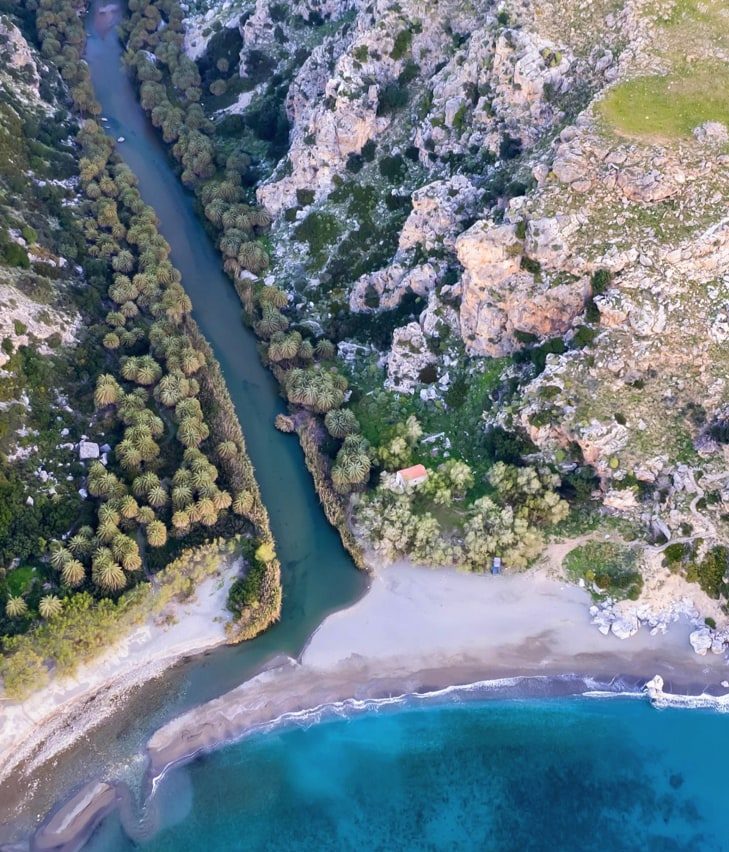
Visitors typically reach Preveli Beach by driving from Plakias toward Preveli Monastery, parking, and then walking 15-20 minutes down a steep path. Boat services from Plakias or Agia Galini provide an alternative, and seasonal buses from Rethymno are available during peak season. Car rental offers flexibility and is considered a solid transportation option to get to Preveli. The beach features golden sand mixed with pebbles and calm, clear waters. The blend of cool river water and warm sea creates a distinctive swimming experience, preserved by the beach’s protected status under Natura 2000.
Facilities need to be more minimal to retain Preveli’s natural character. Visitors find only basic amenities, including a seasonal canteen for snacks, with no permanent structures or organized sunbeds. The palm trees offer some natural shade. In 2010, a fire destroyed 70% of the palm forest, but the ecosystem regenerated impressively in the following months. Spring (May-June) and autumn (September-October) are the best times to visit Preveli Beach, avoiding peak summer crowds on weekends. Legend claims Odysseus stayed here post-Trojan War, adding historical allure. Prevely beach is named Preveli Monastery which also carries cultural significance. Visitors should come prepared with water, sun protection, comfortable shoes, and refreshments, essential for the steep descent that offers breathtaking gorge and coastal views.
2. Voulisma Beach
Voulisma Beach, also known as Golden Beach, is one of Crete’s top beaches, with white sand and turquoise waters. The beach is located on the northeastern coast, 12 kilometers (7.46 miles) east of Agios Nikolaos and 22 kilometers (13.67 miles) north of Ierapetra near Kalo Chorio, this 700-metre stretch of beach offers crystal-clear, shallow waters ideal for families. Voulisma Beach’s Blue Flag certification reflects high water quality, safety, and environmental management standards.
Voulisma Beach is accessible by car or public transport, approximately one hour from Heraklion, 40 minutes from Hersonissos, 30 minutes from Malia, and 15 minutes from Agios Nikolaos. Free parking is available on-site and at the nearby Old Road parking area. Facilities include sunbeds, umbrellas, changing rooms, showers, and toilets. A café and restaurant above the beach offer snacks and drinks with panoramic bay views accessible via a staircase. The beach also offers water sports such as jet skiing, water skiing, and snorkeling, ideal for marine exploration due to its clear waters.
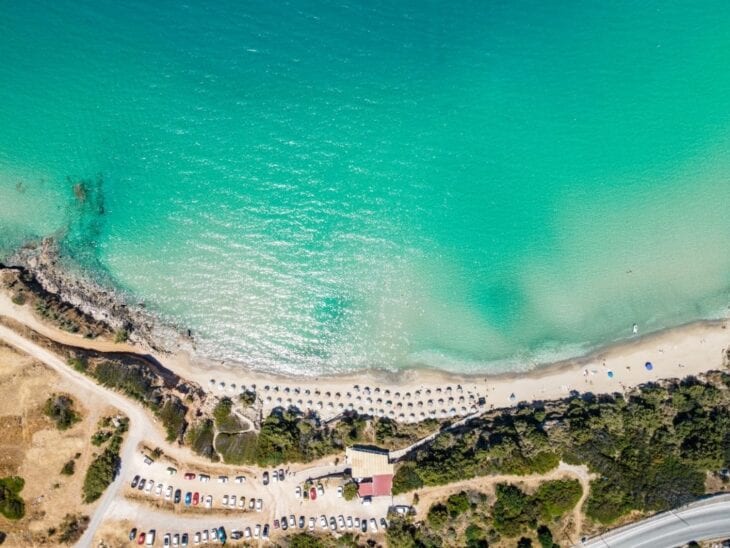
For visitors seeking solitude, a smaller cove on Voulisma Beach’s western side offers privacy, wind protection, and fewer amenities. The surrounding landscape of olive groves, citrus trees, and pine forests provides a scenic backdrop. Underwater, the white sandy bottom enhances the water’s blue color, attracting snorkelers who may encounter fish shoals, sea anemones, rainbow wrasse, cardinal fish, and sea bream species. Tamarisk trees and Mediterranean vegetation around the beach create habitats for local bird species. Nearby attractions include the ancient ruins of Lato and the island of Spinalonga. Voulisma Beach is ideal from June to September, though becomes crowded, particularly on weekends.
3. Kalypso Beach
Kalypso Beach, known as the Pirates’ Fjord, is a rocky beach in Plakias, Crete, about 31 kilometers (19 miles) from Rethymno city. The beach’s sheltered cove, created by cliffs, provided a refuge for pirates around 300 years ago. Kalypso Beach is famous for its clear turquoise water, allowing visibility up to 40 meters (131 feet) underwater, making it ideal for swimming and snorkeling. The cove’s protection from harsh weather and nutrient-rich currents supports unique marine life, attracting occasional sightings of turtles and seals.
Access to Kalypso Beach is easiest by car, as public transport options are limited; visitors can park above the Kalypso Cretan Village Resort & Spa and then walk through the property. The resort provides amenities while preserving the beach’s natural atmosphere, offering sunbeds, umbrellas, and a diving club. Activities include swimming, snorkeling, scuba diving, beach tennis, hiking, and pedal boats, though the beach is not nudist-friendly. Families benefit from the calm waters and essential facilities, with food and refreshments available at the nearby resort.
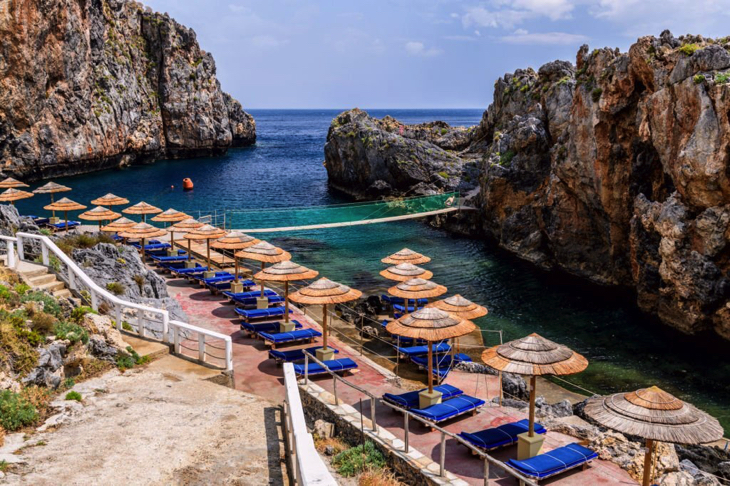
Kalypso Beach’s setting, framed by cliffs, creates a peaceful and less crowded atmosphere than other Cretan beaches. Surrounding trails lead to nearby beaches like Damnoni Beach, offering excellent hiking options. The clear waters and diverse marine life attract underwater exploration, while the cliffs provide striking sunset views. Kalypso Beach is best visited during the primary tourism season from April to mid-October, with the cove’s natural protection ensuring calm waters suitable for swimming throughout this period.
4. Falassarna Beach
Falassarna Beach, one of Crete’s finest coastal destinations, lies 59 kilometers (36.66 miles) west of Chania and 17 kilometers (10.56 miles) west of Kissamos, at the western base of the Gramvousa peninsula. Recognized for its beauty, it has been voted the best beach in Crete and consistently ranks among Europe’s top 10 beaches. The beach’s distinct white and pink sands, turquoise waters, and an expansive shoreline create a unique tropical ambiance. The main beach, Pachia Ammos, extends one kilometer (0.62 miles) with a width of 150 meters (0.09 miles), providing ample space for visitors, which helps prevent overcrowding despite its popularity.
Visitors can reach Falassarna Beach by car or bus from Chania or Kissamos, though renting a car offers more flexibility to explore nearby attractions. Facilities at the beach include showers, changing rooms, snack bars, and a water sports center. Due to its western exposure and northwest winds, Falassarna is ideal for windsurfing, attracting water sports enthusiasts.
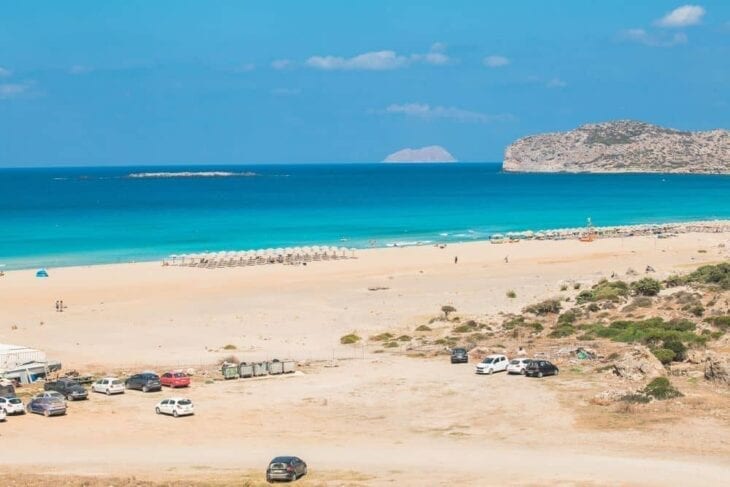
Falassarna Beach is famous for its stunning sunsets, providing a clear view of the sun dipping into the sea, and is often regarded as the best on the island. It becomes a vibrant event spot in summer, highlighted by a significant beach party on the first Saturday of August, drawing locals and visitors alike.
The area around Falassarna is protected under the Natura 2000 network, highlighting its ecological value. The beach complex includes five consecutive beaches, offering options from the bustling main beach to quieter areas. Visitors can explore ancient ruins of the Greco-Roman city of Phalassarna at the northern end, adding historical intrigue.
September is the optimal month to visit Falassarna, with warm sea temperatures and calm conditions. Accommodation options near the beach range from hotels to traditional stone-built villas, catering to varied preferences and budgets. Livadi’s southern section features a rocky seabed ideal for snorkeling, appealing to those interested in marine life. Falassarna’s ecosystem includes wetlands that attract various bird species during winter, enhancing its natural diversity.
5. Red Beach Matala
Red Beach, or Kokkini Ammos, lies 68 kilometers (42.25 miles) southwest of Heraklion and 800 metres (0.5 miles) south of Matala resort in Crete. Its reddish sand contrasts with the clear turquoise waters, giving the beach its name. Visitors can reach Red Beach by hiking from Matala along a trail over Kastri Hill, requiring a 15–25 minute walk with some rocky terrain and a descent down a steep cliff. Alternatively, visitors can take a 5 € ($5.32, £4.36) boat ride from Matala harbour.
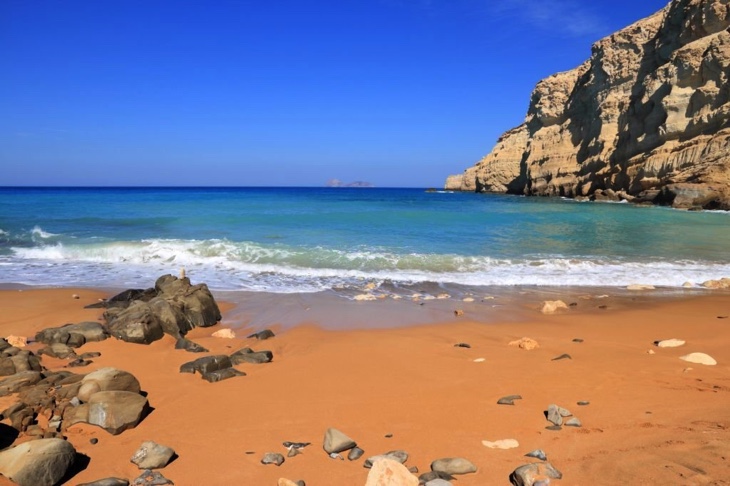
The beach offers clear, shallow waters near the shore, deepening gradually. The sand varies from dark crimson to light pink with a fine to medium-grained texture, making it comfortable for walking. Basic facilities include umbrellas, toilets, showers, and snack bars, though amenities are limited. Red Beach gained popularity as a hippie spot in the 1960s and 1970s and remains nudist-friendly, particularly in the northern section, ranking among the world’s top nudist beaches.
6. Elafonissi Beach
Elafonissi Beach lies 75 kilometres (46.6 miles) southwest of Chania on Crete’s southwestern coast. A shallow lagoon connects a small islet to the mainland, creating a unique formation that lets visitors walk to the island without always getting their feet wet. The beach’s pink-tinted sand, formed by crushed seashells mixing with white sand, draws worldwide attention. Surrounding dunes, cedar trees, white lilies, black rocks, and turquoise waters create an exotic, tropical setting.
Visitors reach Elafonissi Beach by car, public bus from Chania, or organised tours, but car rentals to Elafonissi offer flexibility, but public transport remains reliable during tourist season. The scenic drive passes through traditional Cretan villages and mountainous terrain. The beach divides into two main areas: the eastern side, equipped with umbrellas, sunbeds, showers, changing rooms, and a beach bar, and the peninsula side, which offers seclusion, hidden coves, and bays for privacy.
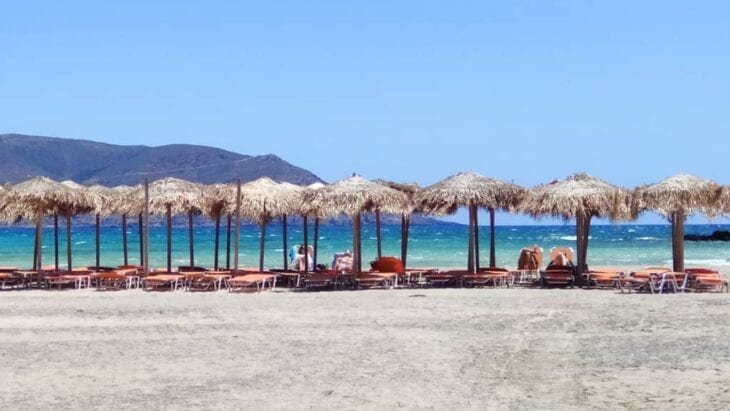
Elafonissi Beach’s shallow lagoon rarely exceeds one metre (3 feet) in depth, making it ideal for families with children. Calm, warm waters suit activities like snorkelling, swimming, and water sports along the extensive shoreline. As a protected area under the Natura 2000 program, Elafonissi supports 110 plant species, providing habitat for loggerhead sea turtles (Caretta caretta) and migratory birds, as well as rare juniper trees and sea daffodils.
Visitors to Elafonissi should arrive early in the morning or late afternoon to avoid peak crowds, particularly in July and August, when up to 2,500 people visit daily. Sun protection, water, and possibly a personal umbrella are essential during peak season. Conservation rules strictly prohibit removing sand, shells, or natural materials from Elafonissi. The area’s delicate ecosystem requires careful preservation, and visitors must respect these environmental protections.
7. Marathi Beach
Marathi Beach lies 17 kilometres (10.5 miles) east of Chania and 5 kilometres (3.1 miles) east of the Creta Naval Base in Souda Bay on the Akrotiri peninsula’s southeastern coast. The beach comprises two sandy stretches divided by a small pier that serves as a harbor for fishing boats and small ferries. Known for its clear waters and scenic surroundings, Marathi Beach ranks among Crete’s finest beaches, featuring shallow, calm waters ideal for families with children. Its southern orientation shields it from strong winds, creating consistently calm swimming conditions.
Visitors can reach Marathi Beach by car, taxi, or limited public transport, with the nearest bus stop in Sternes village. Car rental provides the most convenient access, and the area offers ample parking, though spaces fill quickly on weekends. Marathi Beach provides sunbeds, umbrellas, showers, and toilets, with several traditional taverns, cafes, and mini-markets along the shore offering food and refreshments. The beach is especially noted for its seafood restaurants and authentic local cuisine.
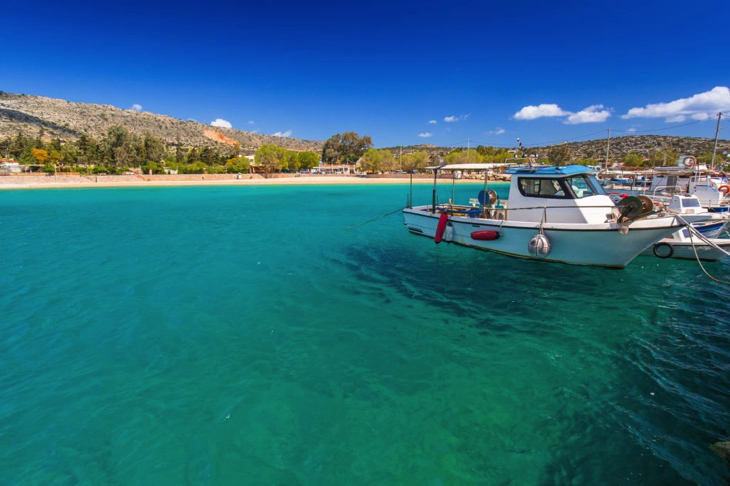
Popular activities include swimming, snorkelling, sunbathing, hiking, beach volleyball, soccer, scuba diving, and boat trips. The shallow, clear waters make it an excellent spot for observing marine life, including fish, octopuses, and sea urchins. A small island, known as Marathi or Palia Souda, lies 500 metres (0.3 miles) offshore. Strong swimmers can reach this pine-forested island, which provides prime scuba diving along its western coast.
History enthusiasts visiting Marathi Beach can explore the ruins of the Roman town of Minoa, found along the beach road to the north. This archaeological site, also referred to as the Small Palace of Minos, contains ancient remnants, including structures, baths, and a semicircular wall visible from the beach. Marathi Beach’s gentle slope and protected swimming conditions make it especially family-friendly, with clean, shallow waters and nearby amenities appealing to families with children of all ages.
The peak season for visiting Marathi Beach is in the summer when all facilities are fully open. Weekends can become crowded with local families, so early morning visits are recommended. The southeast-facing orientation of the beach also allows for excellent morning sunlight, further enhancing the visitor experience.
8. Stavros Beach
Stavros Beach lies 17 kilometres (10.5 miles) northeast of Chania on Cape Akrotiri’s northernmost edge. The beach consists of two distinct areas, making it a versatile destination for varied visitors. The main beach, located within a semicircular lagoon at the base of Vardies mountain, features white sand and shallow turquoise waters, creating ideal conditions for swimming and family activities. Vardies mountain, with its iconic camel-shaped formation, provides a dramatic backdrop to the beach.
Stavros Beach gained international recognition as the filming location for the 1964 film “Zorba the Greek”, where Anthony Quinn performed the famous Sirtaki Dance. This connection brought global attention to the once-quiet fishing village, establishing Stavros as a popular tourist destination with comprehensive facilities.
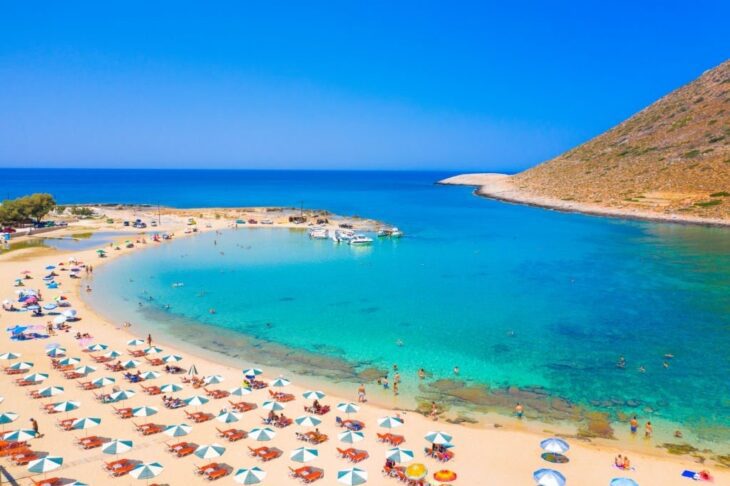
Stavros Beach’s main area is shielded from winds and provides full amenities, including organised facilities. About 200 metres (0.12 miles) northwest, a secondary beach with sand and rocks offers a quieter, less-developed setting but faces greater exposure to waves and wind. Visitors can reach Stavros Beach by car in 30 minutes from Chania or by regular bus. The surrounding area has strong tourist infrastructure, with hotels, restaurants, mini-markets, shops, and cafes, ensuring easy access and convenience.
Stavros Beach offers essential facilities such as showers, changing rooms, and accessibility features for disabled individuals, ensuring comfort for all visitors. The natural beauty of Stavros Beach is enhanced by the contrast between the rugged mountain landscape and the calm beach setting. The water displays a blue-green hue, and the fine, golden sand contributes to a tranquil environment. During peak times, especially on weekends, the main beach can become crowded, while the secondary beach remains quieter, offering a more relaxed experience.
9. Vai Beach
Vai Beach lies on Crete’s eastern coast, located 94 kilometers (58,41 miles) east of Agios Nikolaos and 24 kilometres (14,91 miles) east of Sitia. Vai Beach, known for Europe’s largest natural palm forest, has over 5,000 Cretan Date Palm trees (Phoenix theophrasti), creating a tropical landscape unique in the Mediterranean.
The 200-metre-long Vai Beach has fine whitish sand interspersed with pebbles and crystal-clear turquoise waters. The gentle slope of the seabed at Vai Beach accommodates swimmers of varying abilities. This combination of golden sand and palm backdrop sets Vai apart from other beaches in Crete.
Access to Vai Beach is easiest by car, taking approximately 3 hours from Heraklion. Public transportation is available during peak season, yet a car rental provides greater flexibility for exploring. Well-maintained roads enhance the comfort of the journey despite the beach’s remote setting.
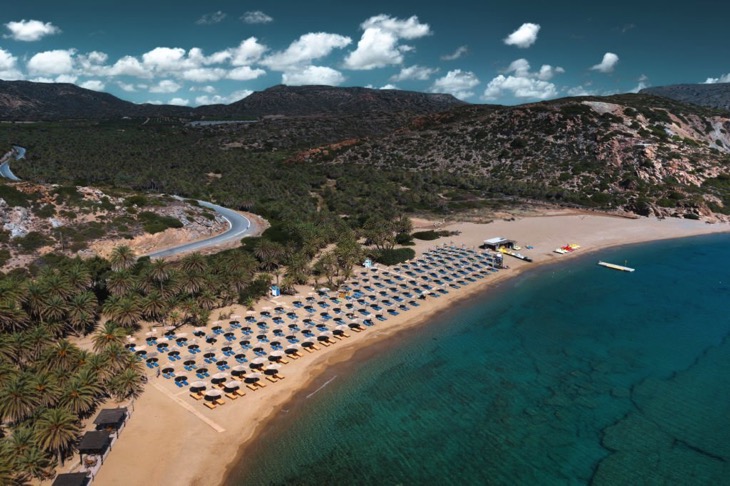
Facilities at Vai Beach include rentable sunbeds and umbrellas (ranging from 10 € to 60 € ($10.62 to $63.72, £8.70 to £52.20)), showers, toilets, and water sports options such as jet skiing, flyboarding, paddleboarding, and snorkelling. The restaurant run by Toplou Monastery serves visitors, and the palm forest offers natural shade with paths for exploring this unique ecosystem.
The northern end of Vai Beach offers more secluded spots for quieter experiences. Nearby points of interest include the historic Toplou Monastery, which manages the area and showcases Byzantine icons, and the Archaeological Site of Itanos, 2.5 kilometres (1,55 miles) away. This fortified monastery adds a cultural aspect to the Vai Beach visit.
The ideal times to visit Vai Beach are early mornings or during spring and autumn when visitor numbers are lower. The beach gained fame in the 1970s with a Bounty commercial, although the coconuts featured in the ad were unrelated to the native date palms.
The surrounding protected palm forest, safeguarded since the 1980s, has rich biodiversity yet faced ecological damage from unregulated camping. To protect the ecosystem, Vai Beach opens only during daylight hours, with overnight stays strictly prohibited.
10. Balos Lagoon Beach
Balos Beach is one of the most iconic and photographed beaches in Crete. It is located on the northwestern side of Chania in the Kissamos region. Balos Beach lies nestled between Cape Gramvousa and the small Cape Tigani, forming a beautiful lagoon beneath the Platiskinos Mountains. This beach is renowned for its striking turquoise waters and unique pink-tinged sand, created by millions of crushed shells.
The lagoon at Balos Beach features shallow, warm waters, ideal for young children, while deeper areas beyond the rocks are perfect for snorkelling. Visitors to Balos Beach have two main options for reaching this scenic destination: taking a ferry from Kissamos port, which includes an opportunity to visit Gramvousa islet, or driving along a dirt road from Kaliviani, which ends with a 1-kilometre walk down to the beach but requires caution. Car rental companies prohibit driving to Balos due to rough terrain that could damage vehicles.
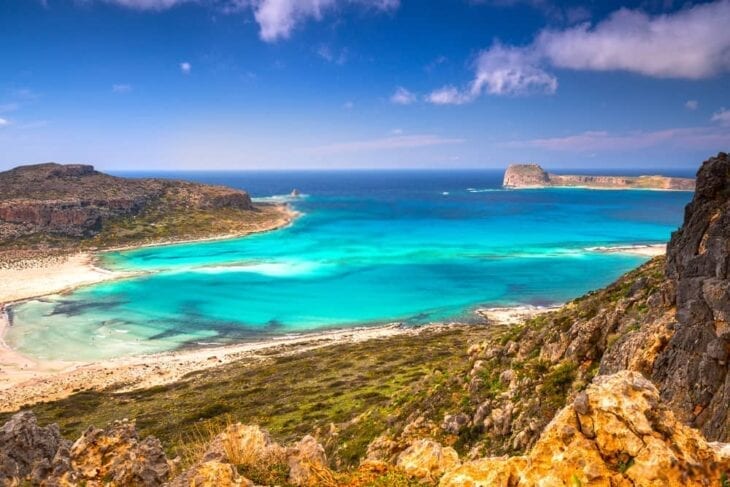
The area surrounding Balos Beach is a protected Natura 2000 site, supporting rare flora and fauna. This region hosts endemic plant species and serves as a habitat for birds such as Eleonora falcons and bearded vultures. Balos Beach also provides shelter for protected species like the monk seal and the loggerhead sea turtle (Caretta caretta).
Balos Beach has limited facilities, offering just a few canteens and umbrellas during peak season. The seabed in parts can be muddy, and shallow waters may occasionally facilitate microorganism growth, sometimes causing unpleasant odors. To enhance their experience, visitors should plan their trip early in the morning before the arrival of ferry boats, especially in July and August when Balos Beach becomes crowded. Essentials to bring include water, sun protection, comfortable walking shoes, and basic provisions due to the limited facilities.
A notable historical aspect of Balos Beach is the ruins of an ancient Roman city called Agnion, which includes a temple dedicated to Apollo located at Korykon Cape north of Balos. The nearby Gramvousa islet adds historical interest with its Venetian fortress, enhancing the allure of the location.
Balos Beach is particularly famous for its stunning viewpoint, which offers panoramic views of the lagoon and is among the most photographed locations in Crete. The combination of white sand, turquoise waters, and the dramatic landscape has attracted notable visitors, including Prince Charles and Princess Diana, who visited on their private yacht.
11. Damnoni Beach
Damnoni Beach, located 35 kilometres (21,75 miles) south of Rethymnon and 5 kilometres (3,11 miles) east of Plakias in southern Crete, is a well-developed tourist resort. Damnoni features a stunning long bay known for its turquoise waters and coarse, whitish sand, making it a top regional destination.
Damnoni Beach is accessible by car or taxi, with plenty of parking spots available, though public transportation options are limited. The journey to Damnoni includes nearby attractions like Ammoudaki Beach, reachable via a short dirt road.
Damnoni Beach is divided into distinct sections for varied experiences. The western end is the most organised, featuring a small river flowing year-round, while the eastern end offers a quieter, peaceful atmosphere.Several small coves with sand and rocks are located near the western harbour area, for those seeking privacy.
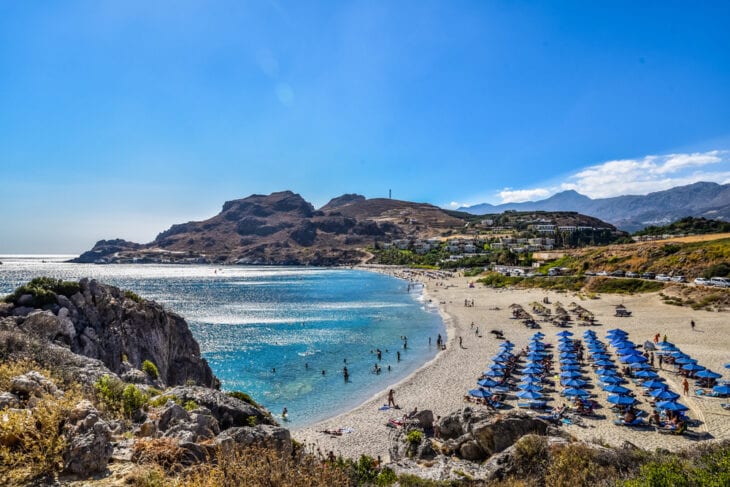
Damnoni provides diverse amenities, including umbrellas, snack bars, showers, changing rooms, and various water sports. Facilities like a scuba diving center, hotels, restaurants, and a horse riding center attract visitors with varied interests. Water sports include jet skiing, sailing, kayaking, and beach volleyball. An artificial football pitch, reachable by a wooden bridge, enhances the offerings.
The surrounding area is ideal for hiking, especially on the rocky peninsula between Damnoni and Plakias Beach. A notable attraction is the Pirate Fjord, a small cove nestled between steep ridges with breathtaking views.
Calm and shallow waters make Damnoni suitable for swimming and various water activities. The beach is nudism-friendly and provides both organised and quiet areas for different preferences. The beach area offers restaurants, cafes, and various accommodations ranging from villas to studios with sea views and modern amenities, making it an ideal choice for extended stays.
12. Skinaria Beach
Skinaria Beach, also called Schinaria, is a natural retreat on Crete’s southern coast, 33 kilometres (20.5 miles) south of Rethymno and near Lefkogia village in the Plakias region. Its highlights include its unique, secluded environment and distinctive visitor experience.
Skinaria Beach’s landscape is diverse, featuring soft grey-beige sand and fine pebbles with crystal-clear turquoise waters that provide visibility extending over 40 metres (131,23 feet). The beach environment includes small freshwater ponds, fed by springs from Kouroupa mountain, creating a tropical-like landscape with lush vegetation. Skinaria Beach’s seabed is rocky, but the northern side has sandy sections, making it one of Crete’s most marine-rich ecosystems.
Skinaria Beach’s underwater visibility and abundant marine life attract diving and snorkelling enthusiasts. The waters are teeming with morays, blackfish, octopuses, and local fish species, making it a preferred spot for Crete’s scuba diving fans. Scuba programs frequently include Skinaria Beach due to its biodiversity and appeal for marine life observation.
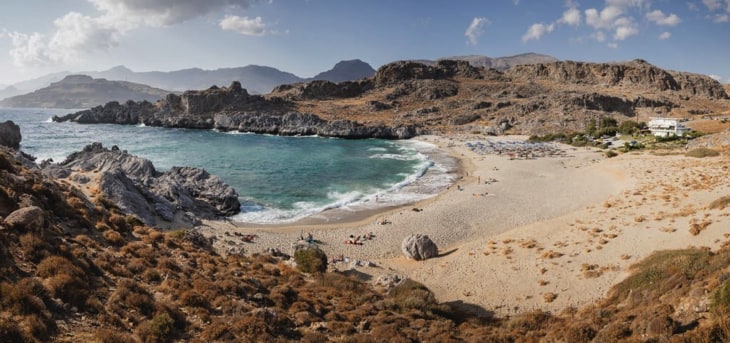
Access to Skinaria Beach is via a narrow road from Lefkogia village, passing by a notable cylindrical cave. The beach has basic amenities while preserving its natural charm, including a garden tavern that offers sunbeds and umbrellas, often complementary with refreshment purchases. The tavern serves fresh Greek dishes made with locally produced olive oil, adding an authentic culinary experience to visitors’ beach outings.
Skinaria Beach is known for its remote, non-commercial atmosphere, popular among naturists and visitors seeking seclusion. Its isolated location and minimal facilities contribute to a peaceful setting, attracting snorkelling and diving enthusiasts.
13. Triopetra Beach
Triopetra Beach, among Crete’s top coastal destinations, features two beaches separated by a small peninsula. Its name comes from three dramatic rocks (“trio” meaning three, “petra” meaning rock in Greek) that rise from the sea, forming a distinct visual landmark.
Triopetra Beach lies 52 kilometres (32,31 miles) south of Rethymnon and 13 kilometres (8,08 miles) southeast of Akoumia village at the foot of Mount Siderotas. Paved roads from Akoumia and Sachtouria provide easy access despite the beach’s remote location, adding to its secluded appeal.
Triopetra Beach comprises two sections: Small Triopetra (Koumado) and West Triopetra (Chatzi). Small Triopetra, in a sheltered bay south of the rocks, mixes sand and rocks, while West Triopetra stretches westward with a long, sandy coastline. Clear turquoise waters and a mix of coarse sand and gravel enhance its visual charm.
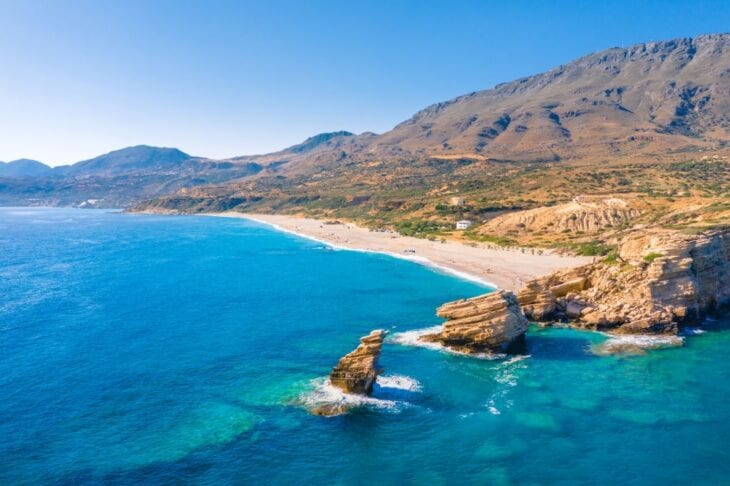
Activities at Triopetra Beach include swimming, snorkelling, and hiking. Small Triopetra’s shallow waters suit families with children. Though largely undeveloped, the beach offers essential amenities like umbrellas, sunbeds, showers, and nearby tavernas serving fresh seafood and Greek dishes.
The ideal time to visit Triopetra Beach is May, October, or November, when temperatures range from 20-26 ℃ (68-78 ℉), providing mild weather and fewer crowds than other Crete beaches. This period allows for a peaceful, authentic experience.
Notable features of Triopetra Beach include a large triangular cave near the rocks, providing natural shade, and the Akoumianos River, which flows into Small Triopetra’s southern end. Panoramic sunset views stretching to Paximadia islands attract photographers and sunset viewers.
Triopetra Beach lacks direct accommodations, but nearby areas offer traditional stone villas, boutique hotels, and family-run lodgings. A Creterental car is advisable for convenient access to the beach’s remote location and for exploring the surrounding regions.
Triopetra Beach is part of the Akoumiani Gialia shoreline, historically a winter shelter for Akoumia villagers. Much of the land remains owned by descendants, preserving the area’s authentic Cretan character.
14. Kolokytha Beach
Kolokytha Beach is a secluded sandy cove on the eastern side of the Spinalonga Peninsula, approximately 12 kilometres (7,46 miles) north of Agios Nikolaos and close to Elounda in Crete. Kolokytha beach derives its name from the Greek word for “pumpkin” or “gourd,” referencing the shape of the nearby Kolokytha island.
Kolokytha Beach, renowned for its pristine white sand and crystal-clear waters, is surrounded by ancient olive groves and wheat fields. Kolokytha is protected by surrounding cliffs and provides a calm environment ideal for swimming and water activities. Its shallow waters make it especially safe and appealing for families with children.
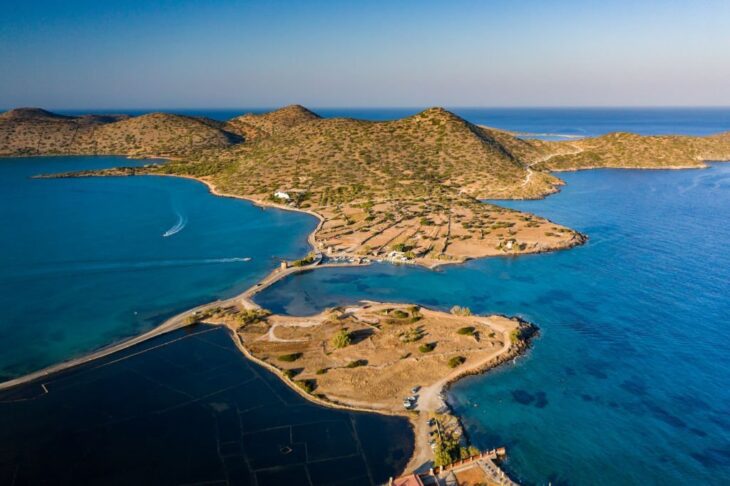
To reach Kolokytha Beach, visitors follow a scenic route from Elounda town, eastward along the shore, passing through historic sites like the salt pans of Elounda and across a narrow strip of land with a small canal built by the French army in 1897. The journey includes picturesque windmills and a charming bridge before reaching the final dirt track leading to Saint Luke church, from where footpaths descend to the beach.
Kolokytha Beach provides scenic views of Kolokytha Island, home to thousands of nesting gulls, and the Byzantine chapel of Saint Fokas, dedicated to Emperor Nicephorus Phocas. Nearby, visitors can explore the ruins of a 5th-6th century early Christian church, with marble capitals and mosaic floors that highlight the area’s historical depth.
Kolokytha Beach is perfect for swimming, snorkelling, and hiking, with its clear waters offering excellent visibility for exploring marine life and underwater rock formations. The beach maintains a natural, unspoiled atmosphere with minimal facilities and no permanent amenities like sunbeds or umbrellas, enhancing its untouched appeal for visitors.
Two secluded bays, known as Vagi, lie south of Kolokytha Beach and can be accessed by a short walk beyond the main beach. Named after the Cretan date palm (vagia), these bays offer a quieter, more private setting and are popular with nudists, providing a tranquil alternative for visitors seeking solitude.
The best time to visit Kolokytha Beach is early morning or late afternoon to avoid crowds. During peak tourist season, excursion boats may bring larger groups, while spring and fall provide a more peaceful experience.
15. Souda Beach
Souda Beach is a scenic beach in Crete, located 41 kilometres (25,48 miles) southwest of Rethymno and 3 kilometres (1,86 miles) east of Plakias. Set where the Finikas River meets the sea, the beach is known for golden sand, clear waters, and unique flora, including Theophrastus palm trees. This area is an important ecological reserve, distinct from the nearby Souda Bay harbour.
Souda Beach lies where the Finikas River meets the sea, creating a distinct landscape with Theophrastus palm trees, native flora, and diverse wildlife, positioning it as a vital ecological reserve in Crete. It’s fine golden sand and turquoise waters offer ideal conditions for swimming, while occasional northern winds can momentarily disrupt the serene atmosphere. Access to Souda Beach is convenient via a paved road, with options for public transport or car rentals, enhancing the experience for visitors interested in exploring the area.
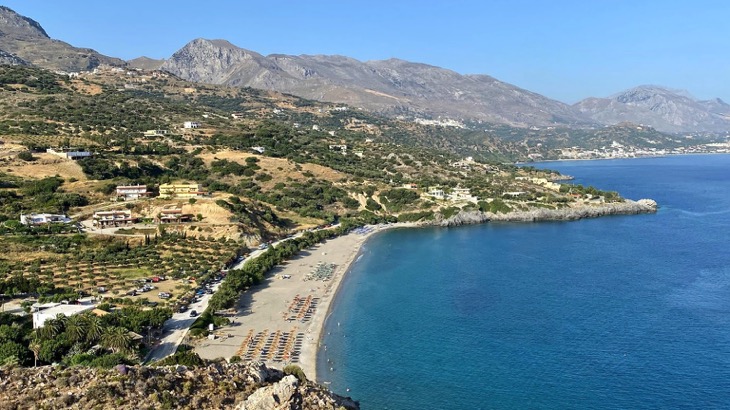
Souda Beach offers umbrellas, sunbeds, showers, toilets, and a taverna with Cretan cuisine. Rocky edges provide fishing and snorkelling opportunities. Once a secluded nudist beach, it now attracts families with organised facilities and shallow waters. Visitors swim, sunbathe, snorkel, and enjoy panoramic views of the South Cretan Sea from eastern rock benches. Arriving early with sun protection, water, and snorkelling gear enhances the experience.
16. Plakias Beach
Plakias Beach on Crete’s southern coast is a popular tourist spot about 36 kilometres (22,37 miles) south of Rethymno. This 1.3-kilometre (0,81 miles) long beach along the Libyan Sea stretches to Cape Mouri and features fine sandy shores with clear blue-green water. Its shallow, calm waters make it ideal for swimming, snorkelling, and family visits.
Plakias Beach on Crete offers shallow, calm waters ideal for families with children. The beach is well-equipped with umbrellas, sunbeds, water sports gear, beach volleyball courts, snack bars, changing rooms, and showers. The eastern Paligremnos area features dramatic cliffs, attracting climbers and showcasing a unique moonlight reflection effect from September to January.
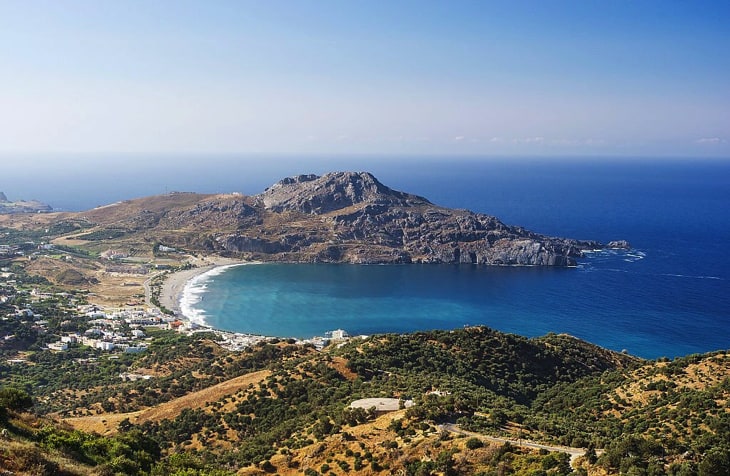
Activities in Plakias Beach include swimming, snorkelling, windsurfing, and paddleboarding, with lifeguards ensuring safety. A clothing-optional area on the eastern end provides a private experience. Nearby attractions include Skinos and Souda beaches, Damnoni, Schinaria, and the Preveli Monastery. The best time to visit Plakias Beach is spring or early summer, avoiding strong north winds. Plakias is easily accessible by road and bus from Rethymno.
17. Loutraki Beach
Loutraki Beach, 16 kilometres (9,94 miles) east of Chania on Crete’s north coast, provides a tranquil setting with soft sand and clear blue water. Loutraki Beach, located in a cove in the Gulf of Souda near the American military base, is perfect for relaxation in scenic surroundings.
Loutraki Beach combines natural charm and convenience with well-organised amenities, featuring shallow, family-friendly waters that deepen gradually. While caution is needed for young children in deeper areas, the calm sea conditions support swimming and water activities. Accessible by car or motorbike, Loutraki offers ample shaded parking and proximity to Chania, enhancing its popularity. Facilities include beachside cafes, restaurants, sunbeds, umbrellas, and a large beach bar with a grassy area, providing complimentary umbrellas and sunbeds for patrons.
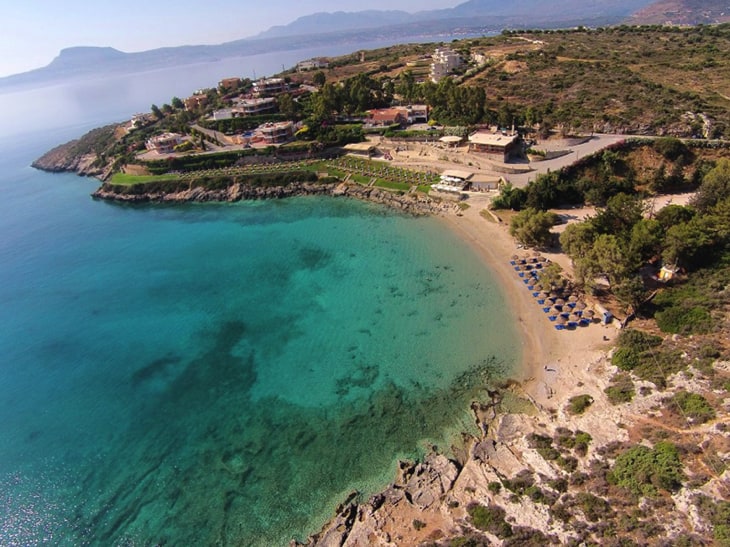
Loutraki Beach is ideal for swimming, snorkelling, and sunbathing, with clear waters for marine exploration. The surrounding landscape provides scenic hiking opportunities, enhancing its appeal as a relaxing yet active destination. Nearby, historic monasteries like Agia Triada and Gouverneto offer cultural exploration, while accessible areas like Marathi Beach make Loutraki a strategic base for exploring regional attractions. Elevated areas provide panoramic bay views, and the beach’s fine sand, clear waters, and organised amenities ensure an enjoyable experience for locals and tourists alike on Crete’s northern coast.
18. Episkopi Beach
Episkopi Beach, a 3.5-kilometre (2,17 miles) sandy coastline in northern Crete, is located 45 kilometres (27,96 miles) east of Chania and 14 kilometres (8,70 miles) west of Rethymnon. Episkopi Beach is named after the nearby village of Episkopi, which is 2 kilometres (1,24 miles) south.
Episkopi Beach’s soft golden sand and clear turquoise waters extend along the coast, framed by mountains that create a striking backdrop. The beach’s shallow shoreline suits families with children, though stronger waves occasionally require closer supervision.
Visitors access Episkopi Beach via the E75 main road, which links Chania and Rethymnon. Rental cars, taxis, and regular buses from both cities provide convenient transport options. Rental cars offer greater flexibility for exploring and reaching various beach sections.
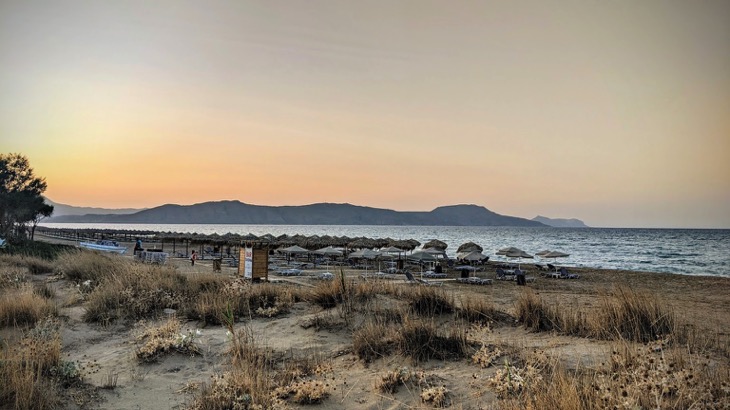
Episkopi Beach’s western section is well-organised, providing lifeguards, showers, changing rooms, and beach bars. Visitors can choose equipped areas with sunbeds and parasols or seek quieter spots near the eastern Petres bridge for more privacy.
Episkopi Beach supports popular activities like swimming, sunbathing, and water sports, especially windsurfing and kitesurfing, thanks to favourable wind conditions. In Episkopi beach, Restaurants, cafes, and bars cluster around the beach’s central section, where ample parking is available.
Summer, from June to September, provides optimal conditions for visiting Episkopi Beach, with warm, sunny weather typical of Crete’s Mediterranean climate, which delivers about 300 sunny days annually. Visitors should observe red flag warnings during days with strong waves. Episkopi Beach is bordered by the Mouselas river to the west and Petres gorge river to the east, creating a unique river-mountain landscape that enhances the beach’s appeal. Nearby attractions include Argiroupolis village, famous for its springs and greenery, and Lake Kournas.
19. Marmara Beach
Marmara Beach, known as Dialiskari Beach, is one of Crete’s most beautiful and secluded beaches, often regarded as the island’s best. The name “Marmara,” meaning “marbles” in Greek, highlights the beach’s unique character, marked by soft, colourful rock formations that add to its allure.
Marmara Beach lies on Crete’s southern coast at the end of the Aradena Gorge, about 85 kilometres (52,82 miles) south of Chania and 5 kilometres (3,11 miles) west of Loutro village. Marmara is located between the Aegean and Libyan Seas, and its unique coastal location enhances its reputation as one of Crete’s top beach destinations.
Marmara Beach is distinguished by its crystal-clear turquoise waters, colourful rock formations, sea caves, and dramatic cliffs. Dialiskari spans approximately 45 metres (147 feet) in width and features a pebble shoreline rather than sand. Marmara Beach is difficult to access, with no direct roads leading to it. Visitors can reach it by boat from Loutro in summer or by hiking along coastal trails. This limited accessibility helps preserve the beach’s natural beauty and unspoiled charm.
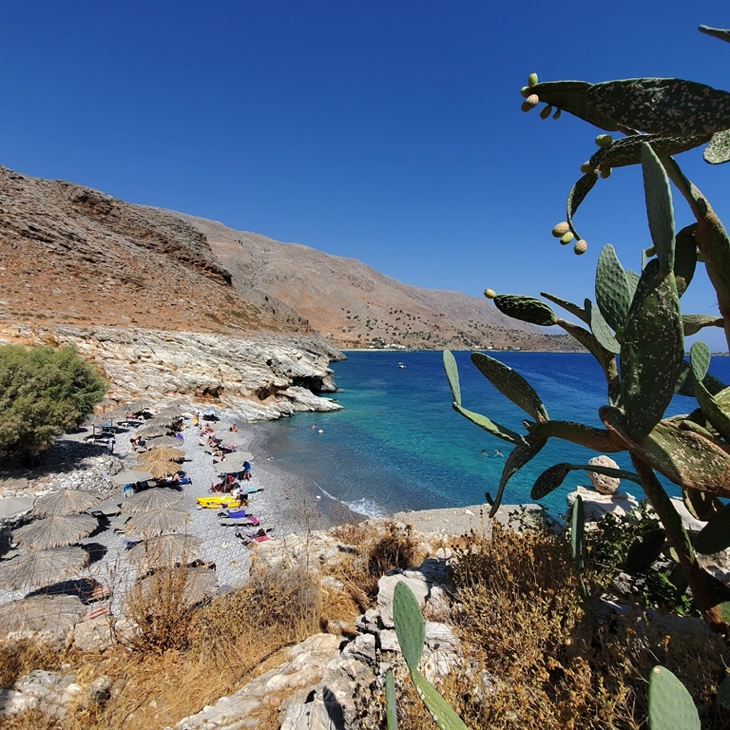
Marmara Beach provides essential amenities, including umbrellas, sunbeds, and a nearby well-rated taverna serving local cuisine, ideal for a relaxing day. The calm, shallow waters make it ideal for swimming. Activities include swimming, sunbathing, snorkeling, and cliff jumping from heights of 7–8 meters (22,97–26,25 feet) with clear visibility, adding appeal for thrill-seekers.
Arrive during morning hours or the off-season to avoid crowds due to its smaller size, for an optimal visit to Marmara Beach. The surrounding area enhances the experience with hiking trails, including the impressive Aradena Gorge, Crete’s deepest. Nearby attractions include sea caves and kayak rentals for about 10 € per hour ($10.62, £8.70), making it an ideal spot for nature and beach enthusiasts.
20. Glyka Nera Beach
Glyka Nera Beach, known as Sweet Water Beach, ranks among Crete’s most scenic beaches and was listed in Europe’s top 20 beaches by The Times of London in 2003. Glyka Nera Beach derives its name from the freshwater springs bubbling up through its pebbles—a rare phenomenon where freshwater meets the sea, creating drinkable water directly on the beach. Sweet Water Beach, located 75 kilometres (46,60 miles) south of Chania and 43 kilometres (26,72 miles) west of Chora Sfakion, is framed by 500-meter-high (1,640.42 feet) cliffs, offering a dramatic backdrop to its deep blue waters and white pebbles, enhancing its scenic appeal.
Visitors to Glyka Nera Beach have two main access options: by boat or on foot. The most common route is via water taxis and small ferries from Chora Sfakion during summer, a 10-15 minute journey. Adventurous visitors may opt for hiking, with two trails available: a 30-minute route from Iligas Beach and a longer hour-long trek from Loutro. These trails are part of the E4 European footpath and are regularly maintained, although they are challenging and feature steep edges.
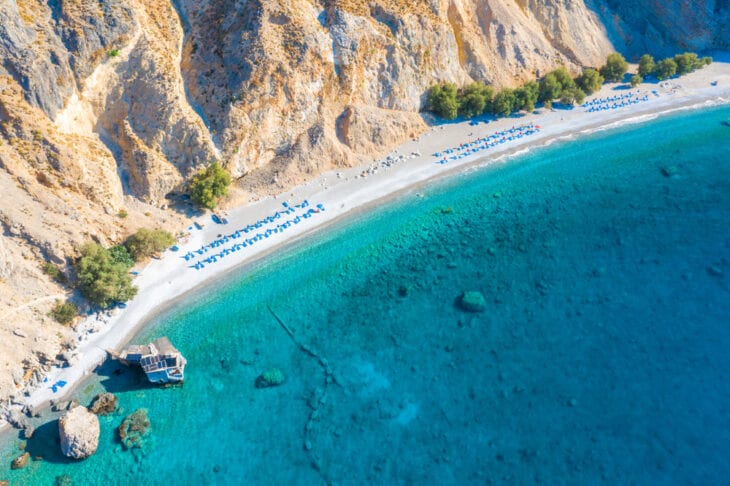
Glyka Nera Beach offers a unique swimming experience due to its freshwater springs, which keep the sea cooler than other Cretan beaches, even in peak summer. The calm, clear waters are ideal for swimming and snorkeling.
Amenities include a small taverna built on a rock that provides food and drinks and rentable sunbeds and umbrellas. Tamarisk trees offer natural shade, and the spring water is drinkable, so visitors don’t need to bring their own.
Glyka Nera beach has two sections, with the eastern side designated as nudist-friendly. Despite its rising popularity, it remains relatively quiet, making it ideal for a secluded experience. Due to the pebbled surface, hiking visitors should wear suitable footwear. The best time to visit Glyka Nera is in the morning when the water is calm and clear.
What are the hidden beaches in Crete?
Crete is home to numerous hidden beaches, ideal for travelers seeking privacy, unspoiled scenery, and a peaceful escape from crowded tourist areas.
Many of these beaches are accessible only by hiking trails, boat rides, or winding paths. The rugged coastline, crystal-clear waters, and pristine sands make these destinations perfect for relaxation, snorkeling, or simply enjoying the untouched environment.
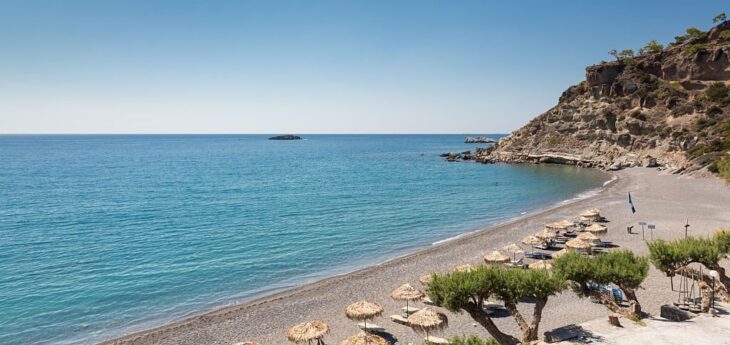
Hidden beaches in Crete often remain preserved and uncommercialized, offering visitors an authentic connection to the island.
Find below a list of the hidden beaches in Crete.
- Seitan Limania Beach. Seitan Limania Beach is a hidden gem featuring crystal-clear turquoise waters, a mix of sand and pebbles, and dramatic cliffs that form a breathtaking natural cove. The beach is located 22 kilometres (13.7 miles) northeast of Chania. Seitan Limania is considered secluded due to its remote location, lack of facilities (no sunbeds or umbrellas), and the steep hike required to access it.
- Balos Beach. Balos Beach is famous for its turquoise lagoon, white-pink sand, and rugged cliffs. Its shallow waters are ideal for children, and the area is part of a protected Natura 2000 reserve, home to endemic birds like Eleonora falcons and bearded vultures. Visitors can reach Balos by car, followed by a 30-minute hike over rocky terrain, or by boat from Kissamos. Balos Beach is secluded due to its challenging access and minimal facilities.
- Falassarna Beach. Falassarna Beach features expansive golden sand, turquoise waters, and captivating sunsets. It is part of the Natura 2000 network, which protects its unique flora and fauna. Public transport options are limited, making driving the most convenient way to visit. Falassarna Beach offers smaller, quieter coves and fewer facilities compared to busier beaches, maintaining a peaceful atmosphere.
- Listis Beach. Listis Beach features sandy shores, clear waters, and distinctive rocks. It is ideal for swimming and snorkeling. Access involves a steep slope descent or a walk from Kamboula Beach. Listis Beach is undeveloped, solitude-friendly, nudism-friendly, and less crowded.
- Agiofaraggo Beach. Agiofaraggo Beach is surrounded by towering cliffs and accessible through a scenic gorge. Its calm, deep blue waters and pebbled shore make it perfect for swimming and snorkeling. Visitors must hike 30-50 minutes through the Agiofarago Gorge, an easy-to-moderate trek, or take a boat from nearby coastal towns. The beach’s remote location and the need for either a hike or a boat trip make it secluded.
- Kedrodasos Beach. Kedrodasos Beach features white sand, turquoise waters, and a juniper forest that provides natural shade. As part of a protected nature reserve, it remains unspoiled by mass tourism. Visitors can also walk from Elafonisi Beach via the E4 European path. Kedrodasos Beach is considered secluded and hidden due to its remote location, lack of facilities, and minimal tourist infrastructure.
- Agios Pavlos Beach. Agios Pavlos Beach has clear green waters and a rocky seabed. Visitors can reach the beach via a long hike along the E4 European Trail, which takes 50-60 minutes from Agia Roumeli, or by boat. No direct road access is available. The beach’s isolation, requiring significant effort to access, ensures minimal crowds. Its lack of amenities adds to its unspoiled charm.
- Kommos Beach. Kommos Beach boasts fine golden sand, crystal-clear waters, and beautiful sunsets. Parking is available near the archaeological site, with easy access from nearby villages. The beach’s protected archaeological status, lack of hotels, and minimal facilities maintain its hidden and secret atmosphere, making it popular among naturists and those seeking peace.
- Matala Beach. Matala Beach features soft golden sand mixed with pebbles, surrounded by cliffs with ancient caves. The crystal-clear waters are ideal for swimming and snorkeling. Parking is available near the beach, and visitors can also hike 20-30 minutes to the nearby Red Beach. Matala has some facilities, its location at the end of a small valley and its limited tourist infrastructure.
What are the naturist beaches in Crete?
A naturist beach in Crete is a secluded area where individuals enjoy activities like sunbathing, swimming, and other forms of recreation without clothing. Nudist beaches celebrate the naturist philosophy, emphasizing personal freedom and connection with nature.
Crete does not have officially designated naturist beaches, but many secluded and unspoiled beaches welcome naturism. Visitors should research specific locations and understand local customs before visiting.
Beaches in Crete are generally not exclusive to naturists, and the level of nudism acceptance varies. Visitors should be mindful of the location, time of year, and cultural norms.
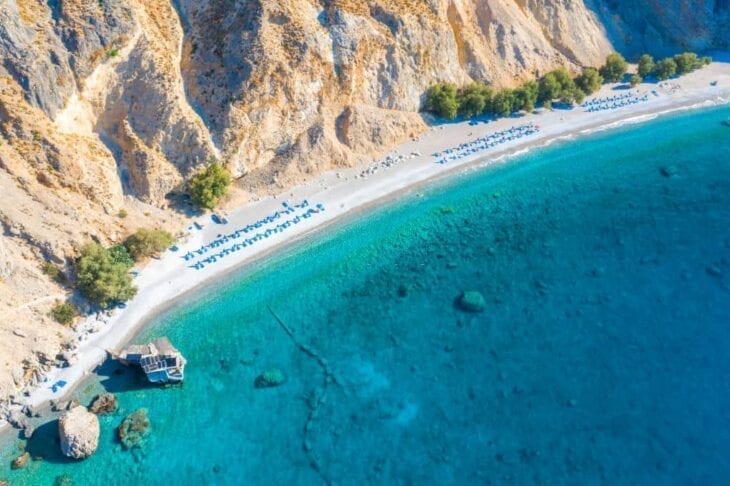
Naturist beaches in Crete do not have official regulations but follow unspoken rules of courtesy and respect. These include maintaining personal hygiene, refraining from inappropriate behavior, and respecting the privacy of others.
When visiting a naturist beach in Crete, bring essentials like towels, sunscreen, water, and any personal items to ensure comfort. Respect the unspoken code of behavior by carrying a discreet cover-up for non-naturist areas.
Which is the best time to visit Crete for swimming in the beach?
The best time to visit Crete for swimming is between late May and early October, when the weather is bright, pleasant, and swimming-friendly. For warm waters with fewer tourists, consider visiting in May, September, or October. During May and early October, travelers can enjoy swimming without the large crowds typical in August and early September.
What are the top things to do in Crete besides the beaches?
Crete has many attractions to offer. Archeological sites, museums, and hiking should be the top things to do in Crete besides beaches. Crete has plenty of historical ruins that will surprise each tourist. The palace of Knossos is also located in Crete that is definitely worth a visit. Mythological stories can also be heard in some places in Crete, wherever a tourist goes. Their museums are full of exhibits from different eras, powerful history, arts, and culture. Hiking is also a must in Crete to fully explore the wonders of the island. There are mountains that hikers can visit, as well as the Mountain of Ida, where it was the legendary birthplace of Zeus. Tourists will truly enjoy their visit as there are many things to do in Crete that await them.
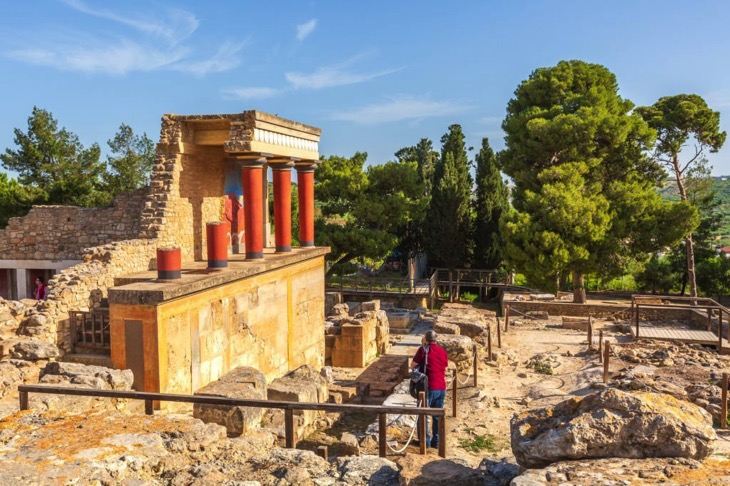
Do you need to rent a car to visit the Crete Beaches?
Yes, renting a car is necessary when traveling to the beaches of Crete. There are some beaches that are not accessible by public transportation, but a car can. Renting a car when visiting a beach will also guarantee the safety and comfort of traveling with companions. Also, cars can take anyone to any beach as long as it has a road and is perfect for other sightseeing plans.
How much does a car rental in Crete cost?
No matter what type of car, transmission, number of passengers, where to take the car, and how many days it will be rented. The price of Crete car rental usually starts at €30 to €40 per day and night. For a week’s trip, it can cost about €250. The price of it came with a good deal of a car with four doors and fully air-conditioned. Tourists can fully use the car anywhere as it has unlimited mileage included with the package of the vehicle. Renters must return the car to the rental company with the same amount of fuel as when they rented it. If renters fail to return the vehicle with the same amount of fuel, the company will charge them an extra fee.
What is the best infographic for the beaches of Crete?
The best infographic for the beaches of Crete is the “Smart Guide to the Beaches of Crete” by Rental Center Crete. This infographic stands out for its comprehensive and visually engaging presentation of 16 of the island’s most famous beaches, carefully selected from over 300 options along Crete’s extensive 1,046-kilometre (650-mile) coastline.
It categorizes beaches based on features such as suitability for families, camping, windsurfing, or their status as tropical paradises. It highlights whether a beach is crowded or holds Blue Flag certification, ensuring cleanliness and safety.
The infographic beaches of Crete is particularly valuable for travelers as it serves as both an inspirational guide and a practical tool for planning visits to Crete’s diverse beaches. Iconic spots like Balos Lagoon, Elafonisi Beach, Vai Beach, Falasarna Beach, and Seitan Limania are featured, providing key information to match specific preferences, such as adventure or family-friendly environments.
Find below an image of the “Smart Guide to the Crete Beaches” infographic.
Copy the code below to embed the infographic into your website:
<a href="https://www.rental-center-crete.com/blog/wp-content/uploads/2015/05/smart-guide-of-cretan-beaches.jpg" target="_blank" rel="noopener noreferrer">
<img src="https://www.rental-center-crete.com/blog/wp-content/uploads/2015/05/smart-guide-of-cretan-beaches.jpg"
alt="Smart Guide to the Beaches of Crete"
style="width:100%; max-width:650px;" />
</a> Published on January 14, 2025















